August 23rd, 2004
Subject: Grooming tips from the monkeys of Borneo
Current Location - Bangkok, Thailand
Local Currency - Baht (B40 = $1us)
Language - Thai
Temperature - 85 and sunny
Songs defining this leg of the trip - Comfortably Numb - Scissor Sisters
Rebel Warrior - Asain Dub Foundation
Well, this may be it. The final installment of the journal. Before I get too weepy and emotional, I'd best get on with it.
Has it really been this long since I've written? All the way back to the full moon party? Yep, I guess so.
My second full moon party was just as good as the first. The first one I went to was nice, because it was the final party for Dave and I, and this one was good because I was with 3 people who'd never seen one before, Jane, Wendy and Tracy. Jane was feeling better after her 12 day illness, so she was able to enjoy it fully. We danced and drank and watched the firespinners until the sun came up. Our goal was to stay up long enough to see the sun rise, which we did.
We spent the next day at our bungalow, partly because we were too tired to go out, and partly because the frequent storms made going anywhere other than the bungalow or attached resturant unattractive. Wendy and Tracy's trip was about to come to an end, so they worked on ways to spend their final few days, while Jane and I worked on our plans to get to Borneo. We found we could get the best deal if we flew out of Kuala Lumpur, as flights to Borneo would still be domestic (both places are in Malaysia), so we booked the flight on line and headed southbound to KL.
Our trip to KL could only be described as 18 greuling hours. It starting out on a rough boat ride (after having to wake up at 6am!), followed by being crammed in a mini bus (aka: a van) with inadequate air conditioning with 12 other people, plus a baby that liked to scream and kick, which just amused his undicipining parents. Ah, the joys of backpacking.
We really only had a day to spend in KL before the flight, so we went to the bird park, which Dave had given a good recommendation as something to do if I ever got back to KL. He was right, it was pretty cool. The bird park is actually a large part of the central park of the city, with a large net over it so the birds cant escape. In theory, its a nice idea, but there are still a lot of cages within the park, presumably to keep the birds separated who might do harm to each other, or perhaps to keep them within view of the visitors. I'd have liked it better if they were all free-flying.
We spent the night wandering through the KL chinatown market, which has to be one of the largest, most bustling (yet touristy and tacky) markets in Asia. Afterwards we grabbed a few beers at the self-proclaimed-famous Reggae bar.
The next day, all we had to do was catch a flight at 2:15. Nothing else. We thought we'd check some things on the internet and then perhaps go up the Com Tower to see the city from up high. Well, email took us a bit longer than expected, so knowing we wouldnt have time to go to the tower, we spent a little longer. We probably dawdled a bit too long, and before you knew it, we were rushing around.
To my best recollection from when I was in KL the last time, the airport was about 20 minutes away. At 1:15 when we caught a taxi, we thought we'd be cutting it short. When the driver told us the airport was 45 minutes away, I knew we had missed the flight. During this 45 minute journey (which the driver did at breakneck speeds) I slowly recalled that maybe it did take longer than 20 minutes from the airport to center city. What city was I thinking of???
We pulled up to the airport at 1:59 (I was looking at my watch every 15 seconds). With only 16 minutes until the time when the plane was to depart the gate, in a very large international airport, I had already thrown in the towel. All the check-in lines were packed, and there wasnt even one that had our flight listed anymore. We went to the service counter, where I was going to ask how to reschedule our flight. Jane, on the other hand says we need to get on the flight and starts demanding to see a manager. The guy ays that even if we were to speak to a manager, there was no time to put the bags on. We agreed to carry them on, and after some serious pleading from Jane, we had our boarding passes, and set off running. We did in fact make the flight, due soley to Janes willingness.
We arrived a few hours later in Sandakan, on the eastern coast of the island of Borneo in Malaysia. Sandakan is a city that has thrived because it is a large port city in the center of the logging and palm oil industry, and happens to be central to all the nature in the area. Theres no reason one would want to do anything in Sandikan other than pass through it.
We headed straight to Sepilok where one of the largest Orangutan sanctuaries is located. The sanctuary is open for a couple hours in the morning and a couple more in the afternoon, so we were too late to check it out for that day.
We stayed at our guesthouse in Sepilok, and ate at the adjacent resturant. As we were eating, we were talking to the guy at the table next to us and an older lady who was sitting at the table next to us had asked us about something in our conversation. She was an older lady, in her 60s or 70s, and was standing there talking to us when her food arrived. The server asked if she wanted the food to be placed at her own table, or at ours. She indicated our table. Something about her demeanor made me think that she was looking for anyone to talk to and was now going to chew our ears off for the next 4 hours.
I really hate to say that, as my first impression couldnt have been more off base. You should never, ever judge a book by its cover, and in this case, that couldnt be more true. Dr Francine Neago turned out to be one of the more interesting, inspirational, and courageous people I have ever met.
Francine had just arrived in Sepilok 2 weeks ago, but she used to work there years ago. In fact, heres her history in a nutshell. She became a doctor of Medicine in her native country of France, then took off in 1965 to Indonesia to help the people there. While there, she fell in love with the wildlife, specifically orangutans. After doing some breif work with them, she was given the opportunity to design the Singapore Zoo, which she did as the very first zoo without cages. Animals were places in habitats which closely resembled their natural ones. After that, she worked in various places around the world helping and studing animals. She has written several scientific papers, and made documentaries and 2 films. She then came to Sepilok several years ago to work in the Orangutan center. She wanted to help the Oranutans on a wider scale. The sanctuary in Sepilok protects the Orangutans within the sanctuary, but it doesnt do anything beyond that. The illegal orangutan trade is big business in Indonesia. People want them for pets, or for zoos or collections and are willing to pay big money. Most of the older ones are too wild to be tamed, so often times, mothers are shot and killed so their babies can be stolen. There were really no centers set up in Indonesia to protect them, so Francine set out there to set one up.
Using borrowed land, she set up a sanctuary using her very modest pension. She had several Orangutans, a bunch of monkeys, a Malay bear, a crocodile (which lived inside the house) as well as different unwanted or orphaned animals, totaling nearly 200 in all.
One day, the officials came to her house and told her that she didnt have the proper authority to run the sanctuary. They spoke in Indonesian to each other in front of her face, unaware that she was fluent and understood every word. They discussed how much they thouhgt they could extort her for. The figure they came up with was US$5000. She didnt even have a fraction of that. The authorities said she would have to face jail time if she didnt pay it, a sentence they had the authority and ability to enforce. Francine told the men she could get it, but would need to make come contacts (although she never had any intention of doing so) and asked that they come back in a week. The men agreed.
Knowing that the men could get to the end of the road and change their mind, or decide to hold her in custody until she "made some contacts", she left her home and her sanctuary within 15 minutes of them leaving. She grabbed one extra outfit, her only cash, and a few valuables and left the country immediately. In a country like Indonesia where corruption is so widespread, its the only thing you can do. Battling it is futile.
Francine left her home of 3 years, a sanctuary that she had built from scratch, and hundreds of animals that she considered almost family. She knows most of them will be sold for pets, food, or skins, or just simply left there to starve to death.
In her haste and fear of running from prison, she left all of her journals, documentation, and photographs of her studies of the past 3 years.
I have to say now that the country of Indonesia sickens me. The country doesnt spend any money on programs to protect any animals, even when people like Francine are willing to devote their lives to it on their behalf. Indonesia also ignores UN sanctioned reserve areas for rainforest areas so diverse and so ecologically important that they merit world involvement. Those areas have been cleared for logging because there are teak trees in it. Teak makes lovely bedroom furniture. Indonesia also offers no protection to people like Francine who would otherwise sit in prison while corrupt men looking for bribes kept her there. That last point in indicative of a lot of places in the world, but I just think Indonesia deserves a big 'shame on you' for their actions against wildlife and nature. Indonesia also consistently ranks the #1 most corrupt country in the world.
But back to Francine. She's now come to Sepilok 2 weeks ago, and already has a proposal to build a 2000-acre sanctuary in Malaysia. She has accepted having to start over, and continues diligenty on her quest to help animals. I've never met anyone so steadfast. She basically says that her reserve in Indonesia may have been taken, but it doesnt mean that animals of the region dont need her help still.
In her proposal, she outlines 2 spots where the reserve could be set up. The Malaysian government is willing to sell her either place at a discounted rate (because its being used as a sanctuary), and she has investors willing to give the money. In a catch-22, she cant get the land until she gets the money, and the investors wont give the money, until she has a deed to the land to secure it with. I think it was more complicated than that, but I dont remember all the details. I'm confident she'll figure it out.
A couple other interesting things we leanred while talking to Francine. She knows Koko. Koko is the Gorilla who became famous 15 or so years ago for learning to communicate by sign language. A lot of people thought at first Koko was not unlike a dog that could respond to human commands, or a parrot that could answer questions in English. But when word spread, people were amazed that they could actually have conversations with Koko. Francine was one of the people who has been fortunate enough to be able to do that. Whole working on her own Orangutan language program where she taught an Orangutan to communicate using a computer, Francines office was close by the office where Koko was studied. She'd go over there and have conversations with Koko. As she recited some of these conversations to us, we couldnt believe that she was talking about having a conversation with a Gorilla. She'd tell us that he'd be signing so fast that she couldnt read it ,and she'd have to ask him to slow down. He'd respond by saying "Oh, I forgot, you're just a stupid human, you're not a smart Gorilla like me." She said he'd make jokes like that all the time, then he'd start signing so slow a baby could read it, moking her. To be able to find out that a Gorilla has a sense of humor just amazed me.
Francine was flying out to KL the following day to talk to government people there about other options. Malaysia has a much more stable government, and is a much better place to set up a center like the one she is planning. The center she is planning will be soley for the preservation of Orangutans and for a select few students to come and study them, unlike other sanctuarys which are set up as tourist attractions.
I have offered to help Francine by building her a webpage for the project, and paying for the registration of the domain name and all the costs associated with hosting the site. Its something that I'll be proud to be a part of. If anyone else would like to help her, you may contact her through her previous website at http://www.orangutanlanguage.com/.
When Jane mentioned to her that she was a contributor to the WWF, Francine noted that only 4% of the money is actually spent on animals, the rest on first clas airfare and the like.
We went to the Sepilok Orangutan sancturary the next day and were amazed at the number of people that had turned out. All the tour groups in Borneo include the Sepilok sanctuary as part of their tours. The sanctuary is open from 9am to 11am, and feeding time is at 10am. All the tour busses are there for the 10am feeding. There is no guarantee that you'll see them, but its a pretty safe bet to make. The reserve is 11,000 acres, and the Orangutans have free roam of the place, or even allowed to leave if they tried. Theres no fences and no cages. But there is a feeding platform on a tree, and a viewing platform safely away from it. So every day, twice a day, food is put out there, and not unexpectedly, the Orangs come out to eat it.
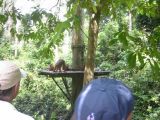
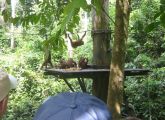
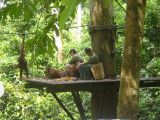
Oddly enough, shortly after they finished eating, 2 of the Orangs started mating. I was a bit shocked when most of the people started laughing at it. I later asked one of the park officials if that was a rare thing to see, and he confirmed that it was. It was something I felt I was more fortunate to witness than something I would have found amusing in 3rd grade.
At about 10:30, all the bus drivers noted that it was time to go to the next stop, which left about 15 out of the 200 people remaining. All the Orangs returned to their habitat except 2 of them, which we sat and watched. By 11am, propably only 5 people remained in the park, including us. At this point, a bunch of Macaque monkeys arrived and started eating the leftovers. They were a little more brazen than their Orangutan counterparts and weren't afraid to jump in to the trees near the viewing platform, and eventually on the platform.
It was well after closing time, but the park official just sat and let us stay and watch. Jane and I took a seat on the viewing platform and watched the monkeys as they watched us.
Monkeys will groom each other as a sign of respect. If a monkey upsets an elder senior monkey, he will groom it by picking lice and debris from his hair for hours. If a male is courting a female, he will do the same. And monkey families will in general, spend endless hours grooming each other.
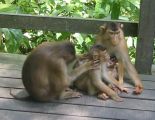

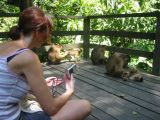
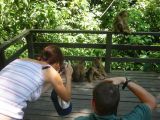
As we sat on the viewing platform, one of the mid-sized monkeys (not an elder one, but not a baby) came slowly up to Jane, and started to groom the hair on her arms. The monkey then shot her a look like "what is THIS??? theres nothing to groom here!!?", noting her lack of arm hair compared to his fellow Macaques. It truly was an amazing moment. Its rare that you ever get to interact with wildlife in such a way.
Finally, the guard asked us to leave, but it was well past closing time. We all felt honored for being able to stay the extra time and see the animals more intimately.
We went back for the lunchtime opening too (our hotel was a 2 minute walk) and were greeted with another surprise. The walk to the viewing platform goes along a wooden walkway and takes about 10 minutes to get there. When we reached the start of the path, we encountered an Orang on the railing, obviously headed for the 10am feeding. People would take pictures and pause for a few minutes, then walk up to the viewing platform. We were too mesmorized. We walked the entire way from park entrance to viewing platform at the slow pace of our new friend. At one point, he stopped to pose for pictures with the sign that reads "Beware of wild monkeys". When we walked up, the viewers on the platform were shocked, as they were all facing the feeding platform, which was the other direction, and didnt expect anything to be coming from behind.
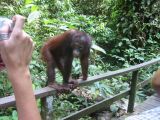
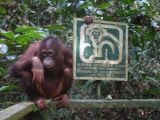
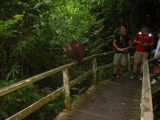
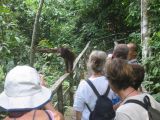
Our friend joined the rest of the Orangs on the feeding platform, but came back to the viewing platform after lunch. Like the morning session, we were allowed to stay after the tour busses had left. We got to spend some more time with our Orang, and he even reached out to Jane at one point, but she just touched his fingers and left it at that, fearing what more contact might do. For the sake of the program, contact with the Orangs is supposed to be limited.
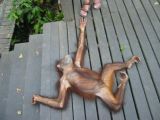



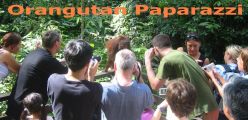
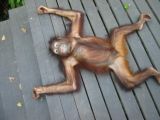
The next day, we headed out to see the Proboscis monkeys. These are weird looking animals which have big noses. Some of my better friends will likely try to point out that yours truly also has a rather large nose. Let me retort by saying that the Proboscis monkey with the biggest nose usually becomes the dominant male of the bunch and his large nose is seen as a very attractive trait by females. So there.

"Could you call us a cab please?"
"Where do you want to go?"
"We're going to the Proboscis sanctuary."
"The tour is RM120."
"Yes, but we want to go on our own."
[Looks of massive confusion]
"Look, we dont want to do the tour, we want to go on our own."
"The tour is RM120"
"Can you just call me a cab, please?"
"Where do you want to go?"
"It doesnt matter where I want to go. Lets just say I wanted to go to Sandakan, or go anywhere."
"The shuttle to Sandakan is RM25."
"I dont want to go to Sandakan, I just want a taxi."
"A taxi to where?"
"How about you call the taxi, and I tell him where I want to go."
[Look of confusion, again]
Basically, you just dont do this in Borneo. There are tours and thats the way you do things. We ended up paying the RM120 each to take the tour, and I wish I could say that was the last time we had to do that, but it wasnt so.
Basically, it breaks down like this. Most of Borneo has been logged or developed as palm oil plantations, or latex production. The remaining areas are privately owned. They have built resorts on them for eco-tourists, but in order to stay on them, you have to book through their companies package. Or forgo seeing the sight.
The Proboscis monkey sanctuary was actually really neat, but sadly a bit anti-climatic to the Orang sanctuary we saw the day before. This sanctuary operates on the same idea of letting the animals live in the wild, but feed them daily. Sadly, it was only erected once it was discovered that the hundreds of thousands of acres that had been cleared for the planting of palm oil trees had forced these two colonies of monkeys in to an area of just a few acres.

Back at our guesthouse, we booked a ticket to turtle island, and although we ran in to the same dilemma, we were more than fortunate to get the tickets. Turtle island usually books up more than a month in advance. We got our tickets for 3 days out, due to someones cancellation.
So, with a couple days to fill, we decided to head to the Poring hotsprings and park. This and the Orang center are the only two things we could find that you didnt need a tour for. We went with a cool English guy we met in Sandikan who was also looking for something to do for a couple of days that wasnt going to break his budget. I'd advise any American against traveling with 2 English people. They tend to gang up on you, and insist that their pronunciation is correct.
The Poring hotsprings were only 4 hours away, and we got there by bus for RM20 which included a free lunch. Our bed for the night was only RM12 ($3.50), although it was dorm style sleeping.






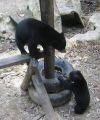
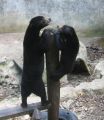



Before we left the Poring park, we wanted to see if we could see some of the wild Orangutans they have in there. The ones in Sepilok are only considered not-wild, as most were rescued from homes or zoos. The ones in Poring are considred semi-wild, as they've always lived in the wild, but are fed by the park once a day. However, these Orangs dont always come for their feeding times, and this day they didnt. But the park rangers knew where to find them, and sure enough, we saw them. They even came walking towards us, and were at one point less than 15-20 feet away. Way cool. The park also had a neat habitat for a couple of Sun bears, which seem to love having the visitors, as they were almost hidden in the back.
We spent a night in Sandakan before heading off for our trip to Turtle island.
Turtle island is about 40km off the coast of Sandikan and when it was found that turtles came there everynight to lay eggs, it was turned in to a sanctuary. A large population of monitor lizards and rats on the island weren't helping the decling turtle population, so a project was installed. A group of environmentalists would set up camp there, and watch the beach every night for mother turtles to come up and lay their eggs, which they do after digging a hole in the sand in which to lay them. The project workers then go around behind the turtles and remove the eggs as they are laid, and the turtle has no knowledge of this. When the turtle has finished, she covers the hole thinking the eggs are inside, and leaves never to return to that spot, just as she would naturally. The eggs are then placed in a hole in the yard of the sanctuary and filled in with sand and given a protective fence around the top. 7 weeks later when the turtles emerge, they are removed from their fenced in area and let safely in to the water.
Our trip to Turtle island was pretty cool. We stopped at another island along the way called Libaran island for lunch. One nice thing about spending $120 on a one-day trip is that they do include meals. But you have to buy your own beers.


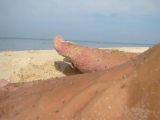
Once we got to Turtle island and everyone was assigned their rooms, we were allowed to explore the island although it was pretty small. We found a nice beach, but couldnt sit on it long due to the sand flies. So, instead Jane and I headed over to the eating area to get some beers and wait for nightfall when the turtles came out. The turtles can come as early as 7pm, or as late at 2am. You just never know with turtles. If they're early, you might have to leave your dinner to go rush out and see them, or you might end up staying up all night to see them.
In our case, we were lucky. Just after we finished eating about 8:30, the first one came up and we all went out to see it. It was just finishing laying 97 eggs, all of which were collected. The turtles ID marking was read, and notes were taken and we left the turtle to fill the hole and return on its own.
Next we headed to the hatchery. There were more than 50 baby turtles to be released tonight, enough for everyone to get a chance to hold one. We were told that we could come up and take one and hold on to it for a couple minutes. We were shown the proper way to hold it between 2 fingers. These little guys instinctively know that its time to go to the water, and are doing everything in their power to get there. So while you're holding them, they're flipping wildly. The back flippers have almost no power, but the front ones have a REALLY strong pull to it for something thats about 3-4 inches long. We put all our turtles back in to the crate and walked to the beach to release them.
The park official placed the crate about 15 feet up from the water, and everyone got as close to crate as they could, without going past the lines drawn in the sand. I really didnt care where I saw it from, so I lined up closer to the water, but still on the line. As it turned out, I had the best seat in the house, as half the turtles had to crawl over my feet to get in to the water. I would have backed up a bit, but some were going behind me and the fear of squashing one made me not want to move my feet at all. Occasionally, I'd see one head the wrong way, and flipped him around.
Photos of these amazing events were impossible, as the flash hurts the turtles eyes.
We tried to see some more on our own that night, but it was against the rules, and after one more beer, they shut up shop, esentially ruling out anything else that could be done other than watching the lightning bugs, which we did for a bit.
Like most of the other tours and things we did that were organized, we had to get up at the crack of dawn. We were on a 6:30am boat back to Sandakan.
Arriving there, we were just too tired to get on a bus for 9 hours to Kota Kinabalu like we had planned. So we checked in to a somewhat plush hotel (as good as you'd find in Sandakan anyway) and went to sleep. Later we tried in vain to figure out something we could do that didnt involve a tour, but instead gave in and booked a $100 1-day/1-night tour of the Sakau jungle.
We were able to modify the tour a bit, and skipped the caving part of the tour. This requires leaving at 8am to go see a cave which has bats, but not at this time of year. Or we could leave at 10:30 and go right to the jungle. Option B, please. This actually gave us an interesting twist, as we had our own guide due to being the only people who requested leaving later. This guide was someone I met on turtle island and swapped patches with (my backpack and his shirt are both covered in patches). We got off on the wrong foot when we noted to him that we found it very hard to do things by ourselves without a package tour. He told us that we should have said something earlier and that he could of told us of a few ways to do it, and basically told us that booking a tour like this is one of the last things we should have done. That just doesnt set the right tone.
However, the tour itself, and his enthusiasm later far made up for it. His name was Azies, and he was the most eager of all the guides that were there. He was the one pointing out all the wildlife and birds, and as an avid birdwatcher and lover of wildlife, he was able to spot things the other guides couldnt and give us information that the other guides didnt seem to have (all groups and their guides were in the same tour boat). Our boat went up and down the rivers and tributaries of the Borneo Jungle, and we saw everything from wild Orangutans (completely wild ones) to Proboscis and Macaque monkeys, Monitor lizards, wild elephants which had recently been grazing on a families farm, and scores of birds including Hornbills.
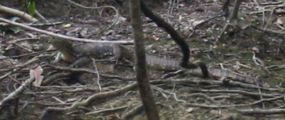
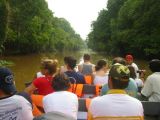
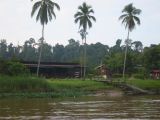
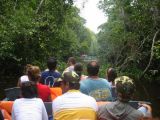
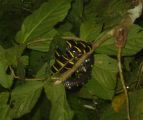
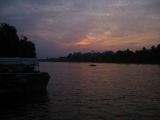


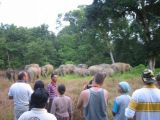
The elephants were a bit of a sad story. Or at least a potential one. A week ago, they wandered on to this property on which there are 2 houses. They are grazing on the grass that would otherwise go to waste, and they only come a few hours a day. But all it will take is for an incident with their children, or the large animals to knock down a building, and the locals will have to kill them. The elephants are not protected, and as an animal on their land, they have the right to kill them. If the elephants presence makes it unsafe for their kids to play, or destroys the property, they may in fact resort to killing them.
That night we did a night-time nature walk, which was cool as you get to see things you wouldnt see during the day, such as birds perched as they sleep. Its also just neat walking around in the jungle in the pitch black. I knew the walk was only supposed to be an hour and a half, which is why I was surprised when at 1 hour and 15 minutes in to the walk we were still headed in to the jungle. I was even more surprised to see a large river on my left, when I thought it should be on my right. Then I realized we were out and back at the start. It I were on my own, I'd swear we were headed 180 degrees in the other direction and would be uselessly lost.
Instead of having Azies take us all the way back to Sandakan the next day, we had him drop us off on the highway where we flagged down a bus headed to Kota Kinabalu. Contrary to what people had told us, it wasnt a bad city. It seemed to have a bit of a nightlife and a good energy about it. We stayed in a budget hotel for the night seeing as we were getting in late, but had already made reservations for a nice hotel the next day. Jane wanted to get in some last minute tanning, so we got a room in a place with a pool, and scheduled in some tanning time. We had dinner and a few drinks on the boardwalk of the city, which again was pretty nice. Walking back, we passed a parking lot which has a large number of big motorcycles, which are pretty uncommon in a part of the world with such a moped culture. We went over to check it out, and a photographer asked Jane to pose for a photo next to one of the bikes. It turns out he's from an Asian motorcycle magazine, and she'll be in the next issue. A fitting thing to happen to Jane who's a rider/owner of some of the fastest bikes ever built.
We made our flight to Bangkok the next day without the near-miss we had getting to Borneo. We decided to stay in the area of Tewet rather than the zanyness of Kho-San road. Its much quieter, and I must say, I like it a lot better.
My paperwork for purchasing the land in Ko Tao was supposed to be ready by the time I got here, but instead its going to take another week. Which left me with a bit longer to spend here than I had planned. We arrived in Bangkok a few days before Janes flight so that she could get some suits for work made, and buy gifts for people back home. What resulted was a day we called Wendytracy day, in honor of the two girls we dubbed the queens of shopping. We got it all taken care of in one long day, and Jane even got custom shoes cobbled (shoes are 'cobbled', not 'made', y'know). We spent a day taking the ferry through the city, which was a real nice way to see the city without the hassle and congestion of traffic.

I've started writing an afterword to the trip, which I'll try to send out in the next couple of days. My eyes are hurting now. :)
Tootles,
-Rick


